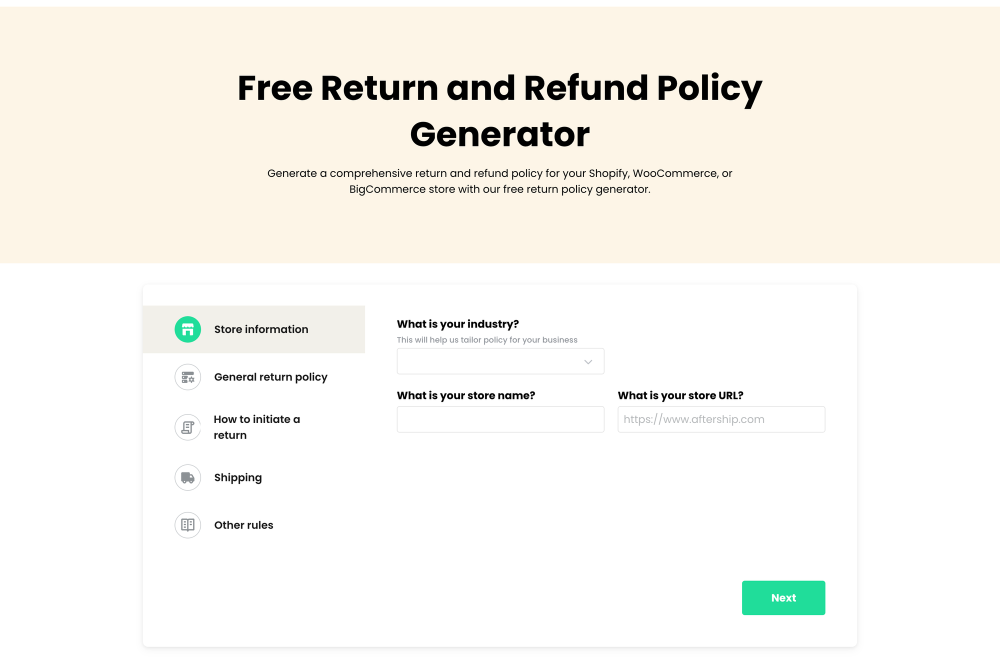What Shopify Merchants Should Know About Returns Management

A well-managed returns process is crucial for eCommerce merchants focused on long-term loyalty and retention. After all, the speed and ease at which a customer can return an unwanted item can determine whether or not they buy from you again.
Shopify merchants have many returns management options, from the basic solution within the platform to more robust integrations like AfterShip Returns. No matter which option you implement for your store, there are some essentials you need to ensure a seamless returns experience. Let’s take a look.
7 essential elements of a returns process for Shopify stores
Clear returns policy
A comprehensive returns policy ensures that you and your customers understand one another. It should be transparent, written in customer-friendly language, and contain the following:
- Which return resolutions your brand offers (e.g., refund to original payment method, refund to store credit, exchanges, etc.)
- Which items are eligible for returns
- How customers should initiate a return
- How long your default return window is
- How long it takes to process returns
- Who pays for return shipping
- Any additional rules you may have
An easy-to-find return policy could save your support team time and provide customers with quick answers. Convenient return policy locations include links in the footer, on your product pages, in order notification emails, and in your store’s FAQ.

Need help writing a returns policy? Try AfterShip’s free Return and Refund Policy Generator.
Seamless returns process
Once you have a solid idea of what you want your returns policy to look like, it’s time to build it out for your store.
First, go to the Shopify App Store and select your returns solution. Ensure it has the following features to build a frictionless returns experience for your customers:
- Self-service returns portal: Give customers the flexibility to initiate their own returns and print return labels, without interacting with customer service.
- Smart returns rules: Set clear automation and shipping rules for return eligibility and faster resolutions.
- Flexibility: Offer a variety of refund and exchange options to delight customers and recover revenue.
- Automation: Use features like instant refunds and exchange incentives to automatically improve customer satisfaction and reduce manual work.
- Carrier and warehouse integrations: Ensure your carriers and 3PLs can be connected for efficient reverse logistics.
In addition to the customer returns experience, look for solutions with clear and streamlined installation and onboarding. The best solutions should be simple to install and can make all the necessary configurations.

Simplified logistics
The easier you can make returning a package, the better the experience for your customer. Ensure that your returns provider enables clear and local drop-off and pick-up options, so they don’t need to go out of their way to return an item.
To cut down on returns costs—and do something good for the planet—consider Green Returns. If you can’t resell an item because it’s damaged, or if processing the return will cost more than the item is worth, consider letting the customer keep or donate the unwanted item rather than shipping it back while still offering a refund or exchange.
Customer communication
Returns can be a stressful experience for customers. Once the return package is out of their hands, it’s a waiting game. Updating customers when the package is received and when the return is processed will go a long way toward alleviating that stress.
Keep customers informed of the status of their return with automated email notifications and centralize the return progress on an updated landing page. This way, your support teams can greatly reduce ticket or call volume and support your customers along their journey.
Comprehensive analytics
Returns can be a valuable learning tool for your business. Analyze your data regularly to gain insights into where you can optimize your product offerings or experience.
For example, if your customers keep returning one particular product because of fit issues, then you can either look into tweaking the product sizing or provide size education on your product page, like this example from Lululemon:
Flexible returns options
Returns don’t have to mean lost revenue. By offering flexible options, you can recapture a sale—and even upsell.
Instead of standard refunds to the original payment method, consider offering refunds to store credit. This will lead to either holding onto that revenue or if a customer buys a higher-priced item, earning even more.
Allowing shoppers to replace an item in a different size, color, or other features also means you won't lose any revenue. These are fast to swap out and quick for merchants and retailers to implement.
Offering an exchange for anything store-wide, whether a bestseller, AI-powered personalized product recommendation, or the customer’s second choice, means an opportunity to upsell for a higher-cost item.
Empowered customer support agents
While automation and self-service can reduce a lot of the hands-on work of returns, some situations call for the judgment of an actual person. Give your support team the power to resolve issues in a way that best supports a deep customer/seller relationship.
For example, if a loyal customer wants to return an item after the 30-day window is closed, you can empower a support agent to process the return anyway. This approach helps you maintain a strong relationship with that customer and ensures they come back.
How PELAGIC GEAR built a winning returns experience for their Shopify store
Fishing apparel and accessories brand PELAGIC GEAR sought to reduce the high shipping costs and strain on their CS team from customer returns. They wanted a robust solution with easy implementation and maintenance without complex development or downtimes — and it had to work seamlessly with Shopify Plus.
The brand implemented AfterShip Returns and saw a 12% decrease in return contact tickets due to the self-service returns portal. They also saw an 18% lift in purchases driven from the portal, where they recommend their latest products to capture more revenue.
PELAGIC GEAR also leverages AfterShip Returns analytics, taking advantage of the 'Top Returns by Variant' feature to help them quickly identify problematic products. They can then investigate quality issues or promote other products as alternatives.
Returns don’t have to mean unhappy customers and lost revenue. Creating an easy-to-navigate, frictionless returns experience for your Shopify store can help get the right products into a customer's hands, retain revenue, and foster long-term loyalty.

